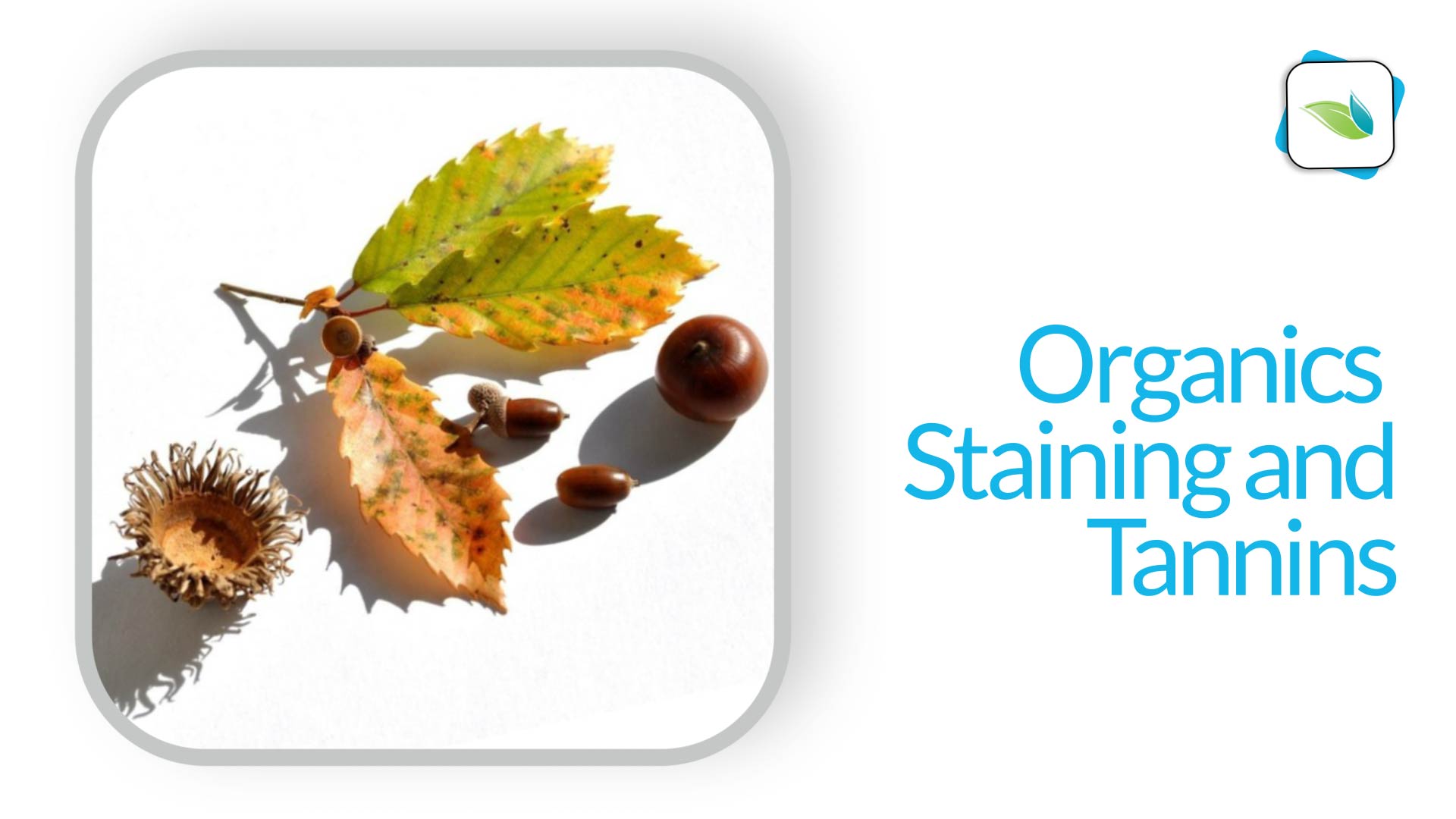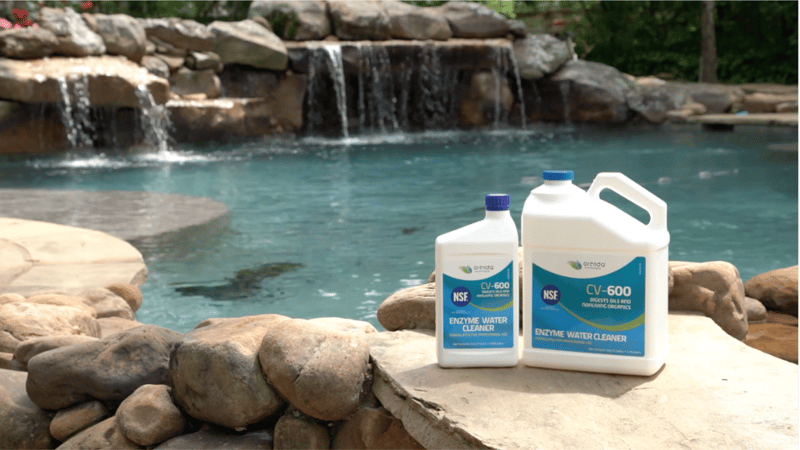Tannins and Organic Staining in Pools

What causes organic staining in swimming pools? Why do leaves, pine needles, acorns, berries and other plant droppings stain pool surfaces? The answer to both questions is tannins, and this article will explain more.
Covered in this article:
- What are tannins?
- How to prevent organic stains
- Cleaning
- Oxidation
- Enzymes
- How to remove organic stains
- Conclusion
What are tannins?
 According to Wikipedia, "Tannins (or tannoids) are a class of astringent, polyphenolic biomolecules that bind to and precipitate proteins and various other organic compounds..." [Tannin molecule image credit: Wikipedia]. Tannins are derived from phenolic acids within living plants.
According to Wikipedia, "Tannins (or tannoids) are a class of astringent, polyphenolic biomolecules that bind to and precipitate proteins and various other organic compounds..." [Tannin molecule image credit: Wikipedia]. Tannins are derived from phenolic acids within living plants.
Let's translate that definition into a more practical one. Tannins are in almost all forms of plant life. They are released when the organic material decays. They have natural colors to them, and those colors tend to bleed onto surfaces and stain.
If any of you have taken organic chemistry courses in college (and passed), feel free to learn more here. For the rest of us, we don't need to know much about tannins (or tannic acid) except that they are non-living organics, and they can cause pool surface staining and discoloration of water.
Two of the most common references to tannins come from tea and wine. Tannins in these drinks provide flavor, sometimes bitterness, and color to the drink. If you put a tea bag in hot water, the water immediately begins to change color. That's because of the tannins in the tea leaves and herbs. Same with wine. There are tannins in grapes, seeds, and other ingredients mixed in. In fact, in doing our research on this subject, most of the information available online was referring to wine and wine stains. Evidently, people spill wine sometimes.
From what we can tell, wine stains are not much chemically different from organic stains in swimming pools.
How to prevent organic stains in pools
Tannins go beyond just organic stains. They can also lead to the discoloration of water. A common organic discoloration of water is when leaves and other tree droppings stay on a mesh pool safety cover all winter long. Rain and snow carry tannins from these decaying organics through the mesh cover and into the pool. 
If the water under the cover is high enough, and/or the pile of organic matter is heavy enough, these tree droppings can also dip into the water itself, causing the mesh pool cover to act as sort of a tea-bag. The organic tannins bleed into the pool, making it brownish-green in color. It is not attractive.
Staining, in the instance of a mesh cover with decaying leaves on it, is not as common as discoloration of water. Stains tend to be caused by leaves, acorns, and other decaying organics directly on the pool surface. Such stains are sometimes very obvious, like when the stains are the exact shape of leaves.
Cleaning
While the pool is closed for the winter, keeping the pool free of tannin staining or discoloration is as simple as keeping tree droppings off the pool cover. Use a leaf blower or broom to get the decaying organics off the cover so they do not contribute tannins to the pool underneath.
When the pool is open, weekly cleaning is recommended to remove leaves and other tree droppings. This just means netting, cleaning skimmer baskets, or vacuuming. There is no substitute for physically removing organic material that contains tannins. In fact, in many of the rescue green pool cleanups we have done, there are piles of decaying organics at the bottom of the pool. That is no coincidence. Such piles of organics add to the chlorine demand and lead to bigger problems beyond organic staining.
With a decent regiment of cleaning the pool, organic stains are unlikely to occur in the first place. It's pools that are neglected or simply overwhelmed with tree droppings that struggle the most.
Oxidation
Once the organics are in the water, chlorine begins to oxidize them. If leaves have been in the water for weeks or months, you may notice they begin to get brittle and fade. Chlorine is doing its best to oxidize the leaf, but it's too much for chlorine alone. Chlorine is in the water to disinfect, not to remove physical debris.
When tannins are released, chlorine and secondary oxidizers like Ozone can oxidize them pretty well, preventing stains. Ozone is excellent at this, except that it is limited by being a point-of-contact system. Leaves should not be flowing through your pipes where ozone contacts the water in the first place (if they are, your strainer basket(s) and filters are failing miserably). If there were a residual of ozone in the water, tannins would not stand a chance.
But alas, chlorine gets used up eventually, and ozone is at the mercy of the circulation rate. So while oxidation itself is effective, it has its limits.
Enzymes

Because tannins and the decaying organic material themselves are...well...non-living organics, we have found great success using CV-600 and CV-700 enzymes to defend against organic staining. Unlike ozone, enzymes are not a point-of-contact system. They circulate throughout the entire pool alongside chlorine, targeting non-living organic material. Tannins meet that description perfectly.
We talk about how to close a pool the Orenda way, and it involves using CV-600/700 enzymes. If you purged in the spring and maintained through the summer, you should be fine for the winter. If not, we recommend an enzyme purge in the fall before the water dips below 65ºF. Honestly, we did not connect the dots of why enzymes were so effective for keeping pools clean during the winter until we did this research. We just knew they worked well. But now it makes perfect sense–enzymes break down tannins.
How to remove organic stains in pools
Now let's talk about actual stains, assuming the organics stayed on the surface long enough to create them. If you have organic stains, there are a few ideas published online on how to remove them. But they all boil down to two basic strategies: physical removal, and chemical removal.
Physical removal of organic stains would be using a stain eraser or pumice stone, or perhaps a diamond pad. It would be physically removing the stain with friction to remove material from the surface.
Chemical removal of organic stains is exactly what it sounds like. This could be using chlorine directly on the surface, such as a trichlor tab, acid to spot treat, a chlorine shock, or enzyme purge. Some combination of those is usually enough, accompanied by thorough brushing.
According to sources online, the best course of action appears to be getting chlorine levels up, using enzymes, and physically brushing or scrubbing the affected areas for about a week. But as mentioned before, all of this comes after physically removing the organic material from the pool and skimmer baskets. More severe stains might be easier removed by rubbing a trichlor tab on the stain directly, but this should be done with caution because trichlor is acidic.
Conclusion
Organics like leaves, grass clippings, acorns, berries, and pine needles contain tannins. Tannins are released when those organics decay. If the decaying is happening in the water, those tannins will be released into the water. Usually, water accelerates the decay of organics. Tannins stain pool surfaces and can discolor water.
Prevention is easier than removal. Maintain regular pool cleaning to remove leaves and other organics each week, maintain decent chlorine levels, and if you struggle with tree droppings in your pool, consider using CV-600 or CV-700 enzymes as a main line of defense against tannins. Enzymes will break down tannins easily and will help prevent the discoloration of your water.
Besides, decaying organics add to the chlorine demand, so getting them out of your water as soon as possible is always a good strategy.
